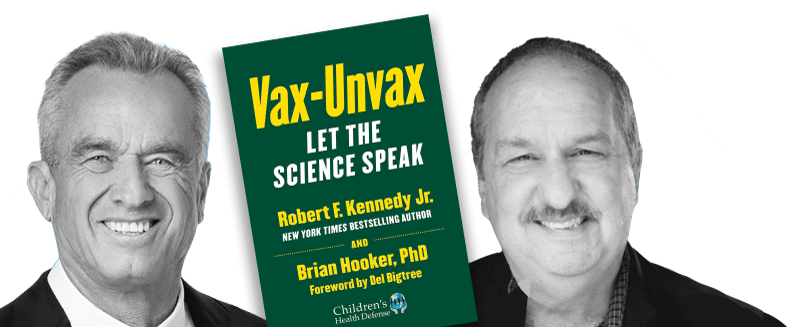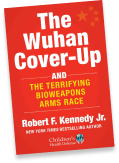Miss a day, miss a lot. Subscribe to The Defender's Top News of the Day. It's free.
Growing concerns about the potential for a devastating bird flu pandemic are driving increased media coverage, including claims that bird flu could be “100 times worse than Covid.”
But a closer examination suggests the level of alarm may be premature, and some argue that fearmongering is motivated by profit.
In recent weeks, cases of the H5N1 avian influenza virus — also known as “highly pathogenic avian influenza (HPAI) A” — have been detected in wild birds, poultry, a variety of mammals including cats and dolphins, and a small number of humans.
The reporting has sparked fears that the virus could mutate to enable efficient transmission between people, according to news outlets like The New York Times and Daily Mail.
Top U.S. health officials like Dr. Mandy Cohen, director of the Centers for Disease Control and Prevention (CDC), say they are taking the situation “very seriously” and monitoring for signs of the virus mutating as it spreads to new animal reservoirs like cattle.
CDC taking bird flu outbreak ‘very seriously’, has vaccine candidates ‘ready to go’ as experts warn against eating runny yolks https://t.co/AJfKE3Ktyc
— NoisyRoom (@terresamonroe) April 5, 2024
However, other experts urge a more measured perspective, pointing out that critical pieces of evidence — like proof of mammal-to-mammal or human-to-human transmission — have not yet materialized.
“It’s not even a ‘new strain’ fiasco like the Covid hysteria days,” journalist Jordan Schachtel wrote on his Substack “The Dossier.” “In fact, the very strain being discussed has been around for decades.”
Dr. Céline Gounder, KFF Health News’ senior fellow and editor-at-large for public health, last week downplayed concerns about infectivity to humans on “CBS Mornings.” She pointed out that the person who reportedly contracted bird flu only had “a very mild case” of conjunctivitis.
“And that’s important to emphasize because it’s not in the lungs,” Gounder said. “It’s not pneumonia, which would make it easier to transmit from person to person.” She pointed out that contagiousness seems to be limited to those directly working with infected animals.
As media outlets ramp up ominous headlines and speculative reporting, some analysts are raising questions about the motives and incentives fueling the bird flu hype — from vaccine industry profits to controversial government-funded virus research to efforts to disrupt the food supply.
‘We are getting dangerously close’ to a pandemic
In 2009, Dr. Joseph Mercola wrote “The Great Bird Flu Hoax: The Truth They Don’t Want You to Know About the ‘Next Big Pandemic,’” detailing then-President George Bush’s spending of over $7 billion based on a prediction of 2 million American deaths from bird flu, only to have no one in the U.S. die.
In his article today on the topic, Mercola recounted the 2014-2017 bird flu hype that again claimed no human victims.
Former CDC director Dr. Robert Redfield in 2022 predicted an imminent bird flu pandemic with 10-15% mortality that would be “much worse than COVID.”
The latest wave of bird flu concerns began escalating in early 2024, as the H5N1 avian influenza virus spread rapidly through wild bird populations and poultry farms across multiple continents, the Daily Mail reported.
On March 26th, the Texas Animal Health Commission announced the first case of H5N1 in cattle at a dairy farm. Kansas, Michigan, Idaho, Ohio and New Mexico followed with reports of additional cases in cattle.
The infected cattle were described as “lethargic,” eating less and producing less milk, but not dying.
By April, the virus had been detected in other mammals, including foxes, dolphins and notably, humans. Three infected cats in Texas reportedly died.
On April 1, the CDC confirmed a human infection from contact with infected cattle in Texas. (The first human H5N1 case in the U.S. was identified back in April 2022 in a Colorado prisoner involved in a poultry culling operation.)
Vietnam reported its first recent human infection with the H9N2 avian flu strain on April 8, although 98 such cases have occurred in the Western Pacific region since 2015. Initially identified in Wisconsin turkeys in 1966, H9N2 reportedly infected its first humans in 1998 in China.
Cohen told The Washington Post the CDC is concerned about the recent developments. “We had not seen avian flu in cattle prior to last week,” she said. “That is new. It’s a reservoir for virus to circulate and potentially, change.”
At a recent meeting of top bird flu researchers, doctors and officials, Suresh Kuchipudi, Ph.D., chair of the Infectious Diseases and Microbiology department at the University of Pittsburgh, declared, “We are getting dangerously close to this virus potentially causing a pandemic.”
Kuchipudi’s concern arose from the virus’s wide global spread and growing list of mammalian hosts, according to the Daily Mail.
Epidemiologist ‘not particularly worried’ about H5N1 spreading to humans
While the expanding range of H5N1 mammalian hosts is concerning, there is still no confirmation that the virus has evolved the ability to transmit efficiently between mammals or sustain human-to-human spread — both key factors necessary for pandemic potential, Schachtel wrote on his Substack.
“We have never seen a case of human-to-human spread of avian flu here in the United States,” Cohen admitted to NPR.
Despite reports that the virus had mutated once inside the recently infected person in Texas, the CDC said the mutation had been seen before and the risk to the public was low.
During the April briefing, Dr. David Swayne, a veterinarian and longtime bird flu researcher, pushed back on the prevailing tone. “Right now, for the cattle cases … there is a huge lack of knowledge that we need to fill.”
The “100 times worse than Covid” claim derives from a reported 52% fatality rate from the 2003 H5N1 outbreak (462 deaths among the 887 infected). Experts noted this rate would likely drop significantly if the virus mutated to spread readily between people, as extremely lethal viruses tend to burn out quickly, the Daily Mail reported.
“Once it’s mutated to infect humans, we can only hope that the [fatality rate] drops,” said pharmaceutical and vaccine consultant John Fulton.
Microbiologist Dr. Gabriel Girouard affirmed that if human-to-human transmission emerges, H5N1’s mortality rate will likely drop but could remain high compared to seasonal flu or COVID-19.
Critics argue the sensationalized coverage and selective quoting of worst-case scenarios are fueling undue panic and obscuring more sober assessments of the current H5N1 threat.
“They’ve already started fearmongering over this when in fact, this is an illness that doesn’t spread from person to person,” said Harvey Risch, M.D., Ph.D., professor emeritus and senior research scientist in the epidemiology of chronic disease at Yale School of Public Health, on a recent podcast.
“It ‘might’ mutate … the ‘might, might, might’ is the fear word,” Risch said. “And that what’s been promulgated out there in order to control the population — you control them with fear. And the media goes along with this.”
This bird flu stuff has been going on for 20 years. Fauci in 2005 said half the population could die! https://t.co/TUyTFgXZSU
— Jeffrey A Tucker (@jeffreyatucker) April 4, 2024
In an April 2 tweet, epidemiologist Francois Balloux, Ph.D., wrote: “I’m not particularly worried about H5N1 spreading into humans” and cautioned that worrying about it “won’t make any material difference” except to make people “miserable.”
A ‘deliberate bioweapon event?
Some analysts suggested financial incentives and controversial research practices may be influencing the alarmist narratives.
Vaccine manufacturers stand to reap massive profits if fears of an impending H5N1 pandemic trigger government stockpiling and widespread public uptake of bird flu vaccines, said Substack writer Jon Fleetwood.
“When you put everything together, it looks like the same kind of thing is happening as what happened with COVID,” he told The Defender.
Fleetwood said the U.S. Food and Drug Administration (FDA) has already approved vaccines like Audenz produced by CSL Seqirus, which contains concerning ingredients like mercury and “may also contain residual amounts of protein other than HA [hemagglutinin] … including MDCK cell protein” from dog kidneys, according to the package insert.
Hemagglutinin is a glycoprotein from the surface of influenza viruses that facilitates attachment and entry to host cells.
In a trial with children ages 6 months through 17, 8% of Audenz recipients developed upper respiratory infections within 21 days of vaccination. Postmarketing reports cited a range of incidents, including swollen lymph nodes, swelling, anaphylaxis, Bell’s palsy, convulsions, demyelination, encephalitis and Guillain-Barré syndrome.
The FDA approved an experimental bird flu vaccine in 2013 and has been stockpiling the bird flu vaccine for perhaps a dozen years.
FDA vaccine regulator Dr. Peter Marks on April 1 said that the versions of bird flu vaccines the U.S. has stockpiled “would be reasonably good matches” for the currently circulating virus, according to Politico.
Meanwhile, the U.S. Department of Agriculture (USDA) has collaborated with Chinese scientists in gain-of-function research on H5N1 avian flu viruses since 2021.
“It’s through all the same characters as during COVID — EcoHealth Alliance, Peter Daszak, the National Institutes of Health,” Fleetwood said.
Mercola also highlighted that gain-of-function research on H5N1 took place in Pentagon-funded biolabs in Ukraine, and that Dr. Anthony Fauci, in his former role as director of the National Institute of Allergy and Infectious Diseases, along with Bill Gates, funded an experiment that mixed the H5N1 and 2009 H1N1 viruses, leading to a highly virulent and human-transmissible respiratory virus.
The USDA is also developing its own H5N1 vaccine, Fleetwood noted.
In March, President Joe Biden signed a bill allocating over $1 billion for bird flu vaccines and pandemic preparedness.
Where have we seen this before?
U.S. collaborates with China to make bird flu more contagious and transmissible to mammals.
Bird flue now discovered in U.S. dairy cattle, transmitted to at least one human being.
Knock it off already! pic.twitter.com/H9asIw2bDf
— Thomas Massie (@RepThomasMassie) April 3, 2024
The U.S. agencies funding research to make H5N1 more transmissible and lethal, while also creating and purchasing vaccines for the virus has led some to question whether a deliberate “bioweapon event” may be in the works, Fleetwood noted.
Dr. Richard Bartlett, former Texas Department of Health and Human Services advisory council member, told Fleetwood, “We need to entertain the possibility that we will be dealing with a bioweapon, not a natural phenomenon.”
Bartlett continued:
“It might be that the mainstream messaging and propaganda broadcast to the American people will be to call it a normal ‘Flu A’ that spun out in nature, when in reality it’s a mass casualty bioweapon event with an influenza virus that was genetically engineered in a lab.”
Researchers at the Wuhan Institute of Virology were working to enhance the virulence of bird flu, Bartlett told The Defender. “There have been reports that bird flu gain-of-function research has been happening at multiple labs for years now.”
“So I’m saying there might be another lab leak, possibly, something that’s not coming from nature,” he warned. “It’s not going to be what came from penguins to otters to dairy cows in Texas to a guy with pink eye.”
Bartlett pointed to the $315 million in the recent omnibus spending bill signed by Biden specifically earmarked for an influenza virus.
“We just funded the next pandemic when that was signed,” he said. “You can almost hear the pitter-patter of feet of different pharmaceutical companies trying to get their piece of the pie for money that has already been set aside.”
Bartlett, who in 2020 brought attention to the inhaled corticosteroid budesonide as an effective COVID-19 treatment, said vaccines are not required for bird flu. “There are already effective prevention and treatments that are inexpensive and readily available that you will not hear about in the mainstream media.”
Attack on food supply?
Some internet commentators suggested the scare-mongering over bird flu may signal another attack on our food infrastructure.
With Cal-Maine Foods exterminating 1.6 million laying hens after becoming infected with bird flu, David Knight on X (formerly known as Twitter) pointed out the vulnerability of the concentrated food operations in the U.S.
“I think they want to maintain this control, this monopolization of our food supply,” Knight said.
🚨🇺🇸 BIRD FLU HITS 2 MILLION CHICKENS IN TEXAS
Cal-Maine Foods in Farwell, Texas, reported a case of H5N1 bird flu, forcing production at the entire facility to come to a halt.
The nearly 2 million chickens affected account for just under 4 percent of its flock, but they must… pic.twitter.com/xV05i9WAY4
— Mario Nawfal (@MarioNawfal) April 2, 2024
Another X user pointed to an article in The Telegraph reporting even small-scale chicken farmers in the U.K. would need to register with the government.
This is what “bird flu” is all about.
Control. You are not to have anything that frees you from the control grid.
Chickens = freedom & safety. pic.twitter.com/L7lJTeKjph
— Zardoz (@yerbooti65358) April 5, 2024
Joel Salatin, author, lecturer and owner of Polyface Farm in Virginia, took a broader view of livestock health in his March article, “Why Are the Chickens So Sick?”
Salatin wrote:
“If thinking people learned only one thing from the covid pandemic, it was that official government narratives are politically slanted and often untrue. In this latest HPAI outbreak, perhaps the most egregious departure from truth is the notion that the birds have died as a result of the disease and that euthanasia for survivors is the best and only option.”
Few of the birds that are killed are in pain or even symptomatically ill, Salatin said. But if even 1 in 1 million tests positive, “The government brings full law enforcement force to the farm to guarantee all live birds die. Quickly,” he wrote.
Salatin recommended letting the virus run its course through bird populations then breeding the survivors to confer natural immunity to future generations.
Reducing flock size and providing fresh pasture by moving mobile shelters daily are better ways of raising healthy chickens, according to Salatin. “Keeping a million birds in a Concentrated Animal Feeding Operation (CAFO) happy and hygienic is harder than a backyard flock, and the disease data supports this.”
Salatin said the USDA and the industry “desperately want to blame wild birds, backyard flocks, and dirty shoes rather than looking in the mirror and realizing this is nature’s way of screaming ‘Enough!’”
He agreed with others that USDA’s ultimate goal is to “find a vaccine to stop HPAI.”
‘They’ll never let a good crisis go to waste’
Even as agencies ramp up surveillance and preparedness measures, Balloux and others stressed the importance of avoiding undue fearmongering that can distort public perceptions and priorities.
“I see no benefit for anyone obsessing over H5N1 now unless they were professionally involved in infectious disease epidemiology,” Balloux wrote. “Try to ignore the doomers/grifters … and live … happily,” he continued.
Fleetwood called for thorough investigations into the potential conflicts so that the government cannot “make the problem (a more lethal version of a virus) and the solution for that problem (a vaccine for that virus) at the same time.”
“They’ll never let a good crisis go to waste, so don’t be surprised to see the mRNA cartel throw themselves into the spotlight, promising another ‘cure’ to our problems,” Schachtel wrote.
Schachtel argued that the intense focus on bird flu doomsday scenarios may be misallocating resources and attention from other pressing global health issues.
“Will this latest narrative stick, or will the scaremongers find a more potent Current Thing to capture your attention?” he wrote.










